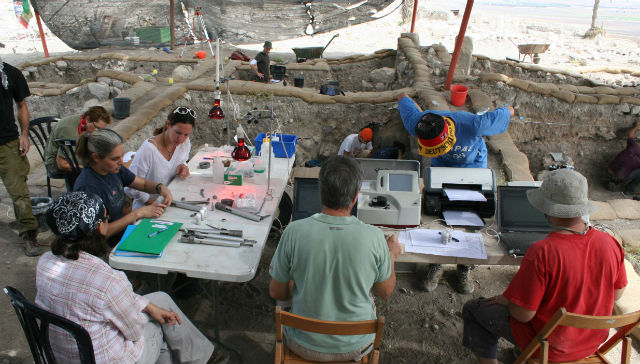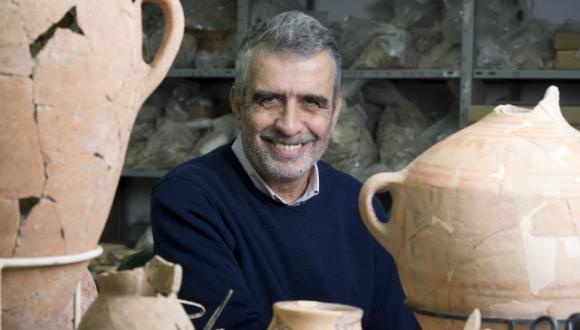Ancient Israel under the Microscope
After one season of disappointing rainfall, Israelis pay more at the vegetable market and feel guilty taking long showers. Imagine how they would cope, however, if the drought continued for decades or even centuries.
TAU scientists have pinpointed such a period of harsh climatic conditions that began around 1200 BCE and parched the Mediterranean region for 150 years. Holding the key to this discovery is fossilized pollen, which when analyzed revealed a marked decrease in the number of oak trees, pines and cultivated olive trees for that period.
“Pollen grain is the most durable organic substance in nature. It can be preserved for hundreds of thousands of years and provides evidence of vegetation in ancient sites,” says Dr. Daphna Langgut, a researcher at the Sonia and Marco Nadler Institute of Archaeology and Curator of Palynology and Archaeobotany at TAU’s Steinhardt Museum of Natural History and Israel National Center for Biodiversity Studies.
Langgut is one of more than 40 exact and life scientists working alongside archaeologists in a sweeping multiyear research project, supported by the European Research Council (ERC), aimed at reconstructing life in ancient Israel. Led by Prof. Israel Finkelstein of the Nadler Institute in partnership with Prof. Steve Weiner of the Weizmann Institute of Science, project scientists employ micro-archaeological techniques to reveal material evidence for historical processes. Scientists such as Langgut work in the field, honing in on excavation layers most likely to yield microscopic evidence and setting up field labs to provide real-time analyses.
Explains Finkelstein, Jacob M.Alkow Professor of the Archaeology of Israel in the Bronze and Iron Ages, Dan David Prize laureate and recent recipient of the Prix Delalande-Guérineau: “Introducing a field lab creates tight cooperation between exact and life scientists and archaeologists. When I need sediment analyzed, I no longer have to relay samples to a lab somewhere and wait days or weeks for answers. Within a few hours, sometimes minutes, I have information that can change the direction of the dig.”
For the drought study, Langgut extracted pollen from layers unearthed deep below the Sea of Galilee and the Dead Sea. Pollen research in Israel is difficult due to the hot climate and meager quantities, and Langgut developed specialized extraction techniques to protect every grain. Material evidence provided by the grains corresponded with ancient documentation of barren fields and rising food prices. The findings plausibly answered a question that Finkelstein and the archaeological community have puzzled over for years: What caused the domino collapse of the mighty Pharaonic, Mycenaean, Hittite and Ugaritic civilizations 3,000 years ago?
What happened, where, when?
Langgut’s findings of a 150-yearlong withering drought would have fallen through the cracks of time if not for her high-resolution sampling method and rigorous radiocarbon dating procedure. Traditionally, sediments are sampled from layers 200 years apart, but Langgut examined 40-year intervals for the period between 3500 to 500BCE.
Prof. Finkelstein stresses, “Without an accurate date, we have nothing. Archaeologists cannot use what is recovered in the field to reconstruct the bigger picture without knowing when an event occurred.” In order to better understand the trade relations and economy of ancient Israel, project scientists sought to synchronize the Levant timeline with the chronology of the larger Mediterranean basin. They worked in cooperation with excavators at three Greek sites. Comparing the Greek findings with those at Israeli sites, Finkelstein’s team succeeded in dating layers from thousands of years ago to within 30 years of accuracy.

Pictured: The researchers' on-site laboratory
Why did the pig become traif ?
Like pollen, bones hold material evidence that can answer sweeping questions. Leviticus and Deuteronomy proscribe the consumption of pork by the children of Israel. But when and why did the pig become taboo? Dr. Lidar Sapir-Hen, Director of the Archaeozoology Lab at the Nadler Institute and Collection Manager at the Archaeozoology at the Steinhardt Museum, analyzes animal remains to understand ancient husbandry and dietary practices.
Historians theorize that the Israelites avoided eating pork to distinguish themselves from their neighbors, especially the hated Philistines. But Sapir-Hen’s analyses of pig bone remains tell a different story.
In the kingdom of Judah, the capital of which was Jerusalem, archaeologists have not recovered any pig remains. Surprisingly, however, bone findings from the 8th century BCE reveal that the inhabitants of the kingdom of Israel avidly raised pigs for consumption. It is known that people from Israel fled to Judah on the heels of an Assyrian invasion in the late 8th century BCE. The pig taboo may have come into being a short while later not to distinguish between Israelites and Philistines but between the residents of Judah and the refugees from Israel – defining status and culture rather than ethnicity in a time of turmoil.
Tracks of human and animal migration
Material evidence is also found in ancient DNA, which tells about origins of populations, migrations, genetics, epidemics and more. “In my work, I zoom in on the molecular level and zoom out to see the big picture,” says Dr. Meirav Meiri, a postdoctoral fellow at the the Steinhardt Museum and an expert on age-old DNA.
Through painstaking investigation of DNA from modern-day boars and ancient remains, Meiri found that the wild boars of Israel, in contrast to populations from neighboring countries, have a European pedigree. Remains from 4,000 years ago display a local genetic signature, but from about 3,000 years ago and onward the European genetic signature becomes apparent. Researchers concluded that the introduction of European pigs to the Levant could have commenced with the migration of the Philistines, and continued in Roman and Crusader times. These pigs eventually replaced the local boar population.
Regarding future research directions, Finkelstein says, “For climate research and ancient DNA analysis, this is only the beginning. The sheer size of this project has nurtured many wonderful young researchers. The impact will be felt for years to come as we continue to ask questions and they continue to find answers.”






